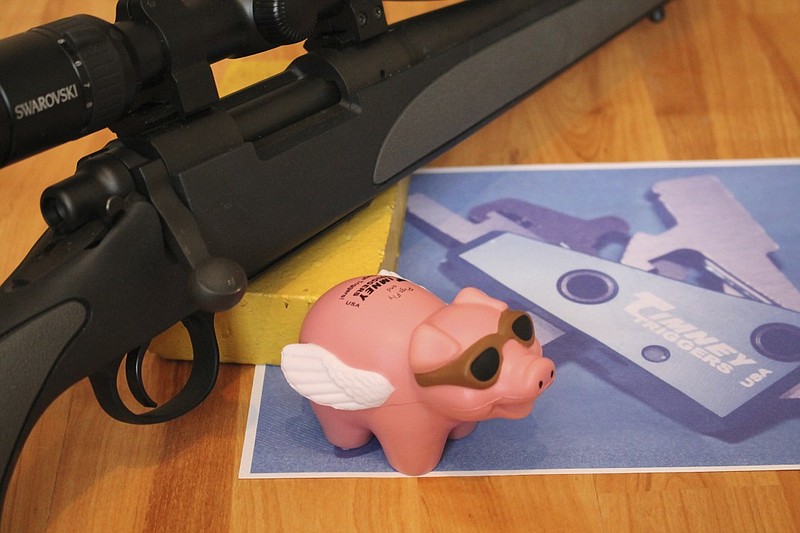You may or may not see a pig fly, but the oldest trigger company in the world is going to do something the owner said it would never do unless, well, pigs fly.
What is that all about? Man, I am so glad you asked!
If you live in the firearms world, you probably know about Phoenix-based Timney Triggers (timneytriggers.com). Since 1946, Timney has been making what many consider to be the finest replacement triggers money can buy. Timney's owner, John Vehr, has a reputation in this industry for surrounding himself with great people and being a stickler for high quality and attention to detail. Rifle shooters appreciate this because, if nothing else, the trigger on a rifle has got to be right.
After Vehr acquired Timney several years ago, he began to immediately invest heavily in technology, cutting-edge machinery, people and - most importantly - a certain mindset. By focusing on the customer and producing the utmost in quality products, Timney quickly became the company that set the standard in aftermarket triggers. By innovating and listening to customers, Timney is now producing more than 170 models of triggers for bolt-action rifles, shotguns, AR-type rifles, semi-automatic rifles and archery triggers.
Today, Timney is housed in a brand new 25,000 square-foot facility full of state-of-the-art technology and machines running around the clock. Although Timney has been in business for more than 65 years, it still remains a company with some of the best people in the industry, building the finest triggers in the world.
Now all of this is well and good, you might say - but Larry, what has it got to do with a two-stage trigger and flying porkers?
For those of you who don't know, a two-stage trigger is not found on most rifles today. With a two-stage model, in the first stage the trigger moves a short distance and comes to slightly more resistance known as the "wall." Once at the "wall," the shooter may adjust his sights (if needed) and start the final squeeze. This will result in the "break" of the trigger, which is the shot being fired.
Now you riflemen (and women) out there know that the single-stage vs. the two-stage trigger argument is one of the Ford vs. Chevy controversies of the gun world. Some single-stage fans will tell you that a two-stage trigger is simply a bad single-stage trigger.
Two-stage zealots (I am one of them) say the two-stage will make you a lot more accurate. You can see how this makes great fodder for gun writers and heated discussions at barbershops and gun ranges. Two-stage triggers were utilized in military rifles for many years; if you think about that, there must have been a reason.
Last spring I spent a few days on the rifle range at Gunsite Academy (gunsite.com) in Arizona, which many consider the premier firearms training facility in the world. I felt fortunate and humbled to be in a rifle class with people who have forgotten more about shooting rifles than I will probably ever know.
Some were writers, some were shooting industry folks, and a couple had spent some time halfway around the world shooting rifles and playing for keeps.
The Timney two-stage trigger was in the testing stage at this point, and the discussion on this was pretty lively. Taking stock of the company around me, I figured the best course was to stay quiet and listen. Early in the week, the vote was mostly on the single-stage side; by the end of the class and a lot of rounds downrange, I believe the two-stage had the majority.
This is another one of those things you will just have to try for yourself. But this is a very comfortable trigger for me to shoot. The minute I replaced the trigger in an off-the-rack Remington 700 in .308 with a Timney two-stage, my groups tightened up. I have witnesses to this - and the targets, if you want to see them.
I don't think it was any secret at Timney that Vehr was not a fan of the two-stage trigger. This would be the reason he probably made a statement that Timney would make a two-stage trigger "when pigs fly."
Yet to his credit, he held true to one of his company's core principles, that of always listening to the customer. So here we are today: Timney is making a two-stage trigger, and I think most of you who shoot rifles are going to love it.
Timney is offering the Remington 700 two-stage replacement trigger in two versions.
The "blue" version is called the "Calvin Elite," which is for shooters who want a lighter trigger pull. (Calvin Motley is the design engineer for product development at Timney, and in my opinion, a firearms genius. I have dubbed him the Trigger Wizard.) The "red" version of the Remington 700 two-stage offers a heavier trigger pull range, but both of these triggers are fully adjustable and can be installed in the rifle on the kitchen table with a minimum of tools - no gunsmith required.
Timney is also making an AR version of the two-stage trigger, and unless I miss my guess, it will be a big hit, too.
If you are a serious shooter and own a Remington 700 or an AR-type rifle, you are going to be compelled to try the Timney two-stage.
Just do me a favor. If you see an airborne porker, try to get me a good picture.
"The Trail Less Traveled" is written by Larry Case, who lives in Fayette County, W.Va., has been a devoted outdoorsman all of his life and is a contributing columnist for The Times Free Press. You can write to him at larryocase3@gmail.com.
